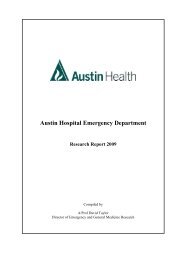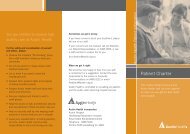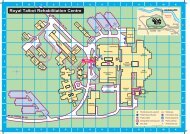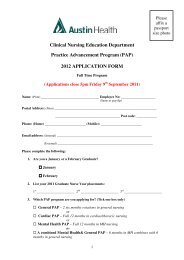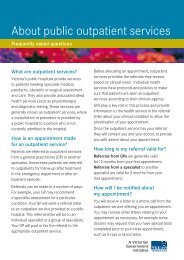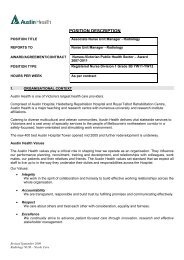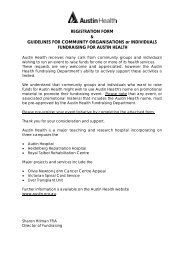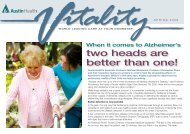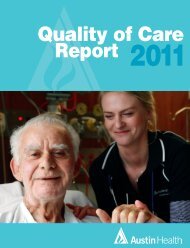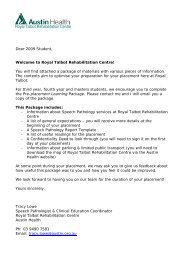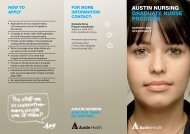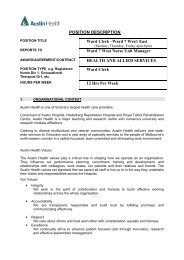Annual Report 2008-09 - Austin Health
Annual Report 2008-09 - Austin Health
Annual Report 2008-09 - Austin Health
Create successful ePaper yourself
Turn your PDF publications into a flip-book with our unique Google optimized e-Paper software.
Tower opened in 2005. ED staff continued<br />
to refine their processes for ensuring<br />
rapid treatment of non-admitted patients<br />
or improved access to care for patients<br />
requiring admission to the hospital.<br />
To reduce unnecessary ED presentations<br />
for residents of residential care facilities,<br />
an outreach program was introduced<br />
following last year’s successful trial.<br />
ED doctors accompany a Hospital in<br />
The Home (HITH) nurse to attend,<br />
assess and treat the patient at their<br />
care facility, avoiding the need to<br />
transfer to hospital. If required, patients<br />
are sent to ED for acute assessment<br />
or admitted to hospital. The program<br />
reviewed 25-30 patients each month<br />
and received positive feedback from<br />
general practitioners, facility staff,<br />
residents and families.<br />
The ‘fast track’ X-ray service, a joint<br />
initiative between ED, Radiology and<br />
Ambulance Victoria, was introduced<br />
to enable timely processing of nursinghome<br />
patients requiring non-urgent<br />
X-rays. The new process reduced the<br />
need for more than one ambulance, as<br />
the patient arrived and was transferred<br />
home in the same ambulance.<br />
This eliminated waiting for a return<br />
ambulance, allowing the patient to<br />
return home quickly and avoiding<br />
unnecessary waiting in ED.<br />
To easily access the expertise of the<br />
state-wide Victorian Toxicology Service,<br />
the Victorian Poisons Information<br />
Centre (VPIC) relocated from the<br />
Royal Children’s Hospital to the ED. In<br />
collaboration with ED, Pharmacy and<br />
Clinical Pharmacology and Therapeutics,<br />
the VPIC is able to provide information<br />
to callers about the effects of poisons<br />
and where required offer advice about<br />
management.<br />
<br />
Flu-Related Presentations<br />
<br />
<br />
<br />
<br />
<br />
<br />
<br />
<br />
<br />
<br />
<br />
<br />
INFECTIOUS DISEASES<br />
Hand Hygiene Australia director,<br />
Prof Lindsay Grayson, oversaw the<br />
implementation of a world-first national<br />
hand hygiene program across Australian<br />
hospitals. The program aims to halve the<br />
rate of antibiotic-resistant ‘superbug’<br />
patient infections.<br />
Following the May outbreak of the H1N1<br />
strain of the influenza virus, or swine flu,<br />
the Infectious Diseases Department took<br />
a leading role in advising hospital and<br />
government on the treatment and testing<br />
of patients. At the peak of community<br />
concern, an additional 90 patients<br />
presented to ED daily. To cope with this<br />
demand, a temporary flu clinic was<br />
established at the Banyule Community<br />
<strong>Health</strong> Centre, in a joint initiative<br />
between Banyule Community <strong>Health</strong><br />
and <strong>Austin</strong> <strong>Health</strong>. Banyule Community<br />
<strong>Health</strong> provided the staff to run the clinic<br />
while the Department provided advice<br />
about patient management protocols.<br />
This clinic enabled <strong>Austin</strong> <strong>Health</strong> to divert<br />
concerned people with mild flu-like<br />
symptoms from the ED.<br />
<br />
Pictured left: “The bullring” at<br />
The Surgery Centre links four theatres,<br />
two endoscopy suites, a recovery unit<br />
and 12-bed short-stay ward.<br />
<strong>Austin</strong> <strong>Health</strong> : <strong>2008</strong>-<strong>09</strong> ANNUAL REPORT<br />
17



